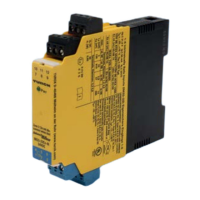Decommissioning and withdrawal from service
© exida.com GmbH TURCK 04-07-14 R001 V2R0.doc; February 8, 2013
Stephan Aschenbrenner Page 13 of 25
• Only the current output 4..20mA is used for safety applications.
• The application program in the safety logic solver is constructed in such a way that fail low
and fail high failures are detected regardless of the effect, safe or dangerous, on the safety
function
3
.
4.2.4 Example explaining the behavior of the safety logic solver
For IM33-**(Ex)-Hi/24VDC, the following scenarios are possible:
• Low Trip: the safety function will go to the predefined fail-safe state when the process
value is below a predefined low set value. A current < 3.6mA (Fail Low) is below the
specified trip-point.
• High Trip: the safety function will go to the predefined fail-safe state when the process
value exceeds a predefined high set value. A current > 21mA (Fail High) is above the
specified trip-point.
The Fail Low and Fail High failures can either be detected or undetected by a connected logic
solver. The SPLC Detection Behavior in Table 6 represents the under-range and over-range
detection capability of the connected safety logic solver.
Table 6 Application example
Application SPLC Detection Behavior
λ
λλ
λ
low
λ
λλ
λ
high
Low trip < 4mA
4
= λ
sd
= λ
du
Low trip > 20mA
5
= λ
su
= λ
dd
Low trip < 4mA and > 20mA
= λ
sd
= λ
dd
High trip < 4mA
= λ
dd
= λ
su
High trip > 20mA
= λ
du
= λ
sd
High trip < 4mA and > 20mA
= λ
dd
= λ
sd
In this analysis it is assumed that the safety logic solver is able to detect under-range and over-
range currents, therefore the yellow highlighted behavior is assumed.
3
For further explanations see section 4.2.4 of this report.
4
The exact “low alarm” current is specified in section 4.1.
5
The exact “high alarm” current is specified in section 4.1.

